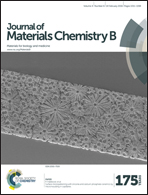Metabolizable dopamine-coated gold nanoparticle aggregates: preparation, characteristics, computed tomography imaging, acute toxicity, and metabolism in vivo†
Abstract
To improve the computed tomography (CT) imaging ability and the toxicity of gold nanoparticles (AuNPs), hydrophilic dopamine (DPA)-coated gold nanoparticle (AuNP) (MSA AuNPs@DPA) aggregates (42 ± 2.65 nm) were obtained by assembling MSA AuNPs@DPA (5–6 nm) with the use of polyethyleneimine (PEI). They rapidly degraded into MSA AuNPs@DPA with PEI in blood. The acute toxicity test showed that the maximum tolerated doses of MSA AuNPs@DPA and MSA AuNPs@DPA aggregates were larger than 4.8 and 4.6 g kg−1, respectively, which are much higher doses than those of the commonly used citric acid-stabilized AuNPs (CA AuNPs) (2.97 g kg−1). The metabolic test in vivo showed that the elimination rates of MSA AuNPs@DPA aggregates and MSA AuNPs@DPA were 0.848 and 0.955, respectively. Most of the aggregates were eliminated by the kidney after 5 days and excreted by urine, whereas CA AuNPs remained in vivo and concentrated in some organs. The t0.5 values of MSA AuNPs@DPA and MSA AuNPs@DPA aggregates were 24.28 and 43.68 h, respectively, meaning that MSA AuNPs@DPA aggregates had a much longer circulation time. Similarly, the CT absorption value of MSA AuNPs@DPA aggregates was much higher than that of the commonly used nonionic iodinated CT contrast agent iohexol and CA AuNPs at the same concentration. Thus, MSA AuNPs@DPA aggregates possess characteristics such as ease of fabrication, long circulation time, hypotoxicity, and excellent CT absorption value, which suggest their great potential applications in vivo.


 Please wait while we load your content...
Please wait while we load your content...